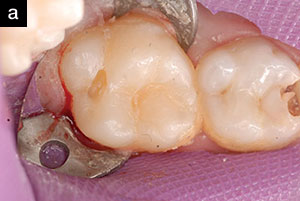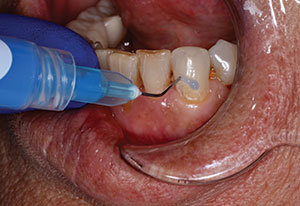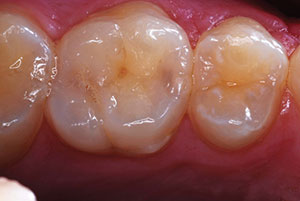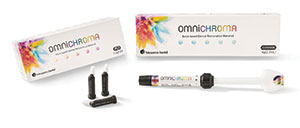 |
| Figure 1. SEM of G-ænial Universal Flo (GC America). |
INTRODUCTION
Results from the US National Health and Nutrition Examination Survey1 show that caries is the most common chronic disease in children. It is 5 times more prevalent than asthma and 7 times more common than hay fever.
The traditional approach to treating caries is to place a dental restoration. The philosophy of “extension for prevention” by G. V. Black was the standard for more than 100 years2 and could be considered obsolete today. This technique removed an excessive amount of tooth structure by extending the cavity preparation into noncarious grooves. At the time of G. V. Black, there were a lack of techniques, methods, and materials for the prevention of caries, and a lack of proven alternative therapies. Caries were often treated at a more advanced stage. There was a lack of understanding of the caries process, including the demineralization and remineralization cycle. The primary dental restorative material at that time was amalgam, and the preparation design reflected the need to create retention. Amalgam offers certain advantages such as ease of placement and good compressive strength, while its disadvantages are an unaesthetic appearance, the need for depth and mechanical retention, and its nonadhesive nature.3 One other negative consequence of amalgam restorations is that they create a future need for total restoration replacement when there is deterioration or margin degradation. Thus, a vicious cycle was created by using amalgam. Small lesions were treated with excessive removal of tooth structure, assuring eventual replacement, causing more loss of tooth structure due to a deeper and wider subsequent restoration.3,4 Consequently, studies show that half of all restorations placed are for replacing existing restorations.5
Brief Background on Minimally Interventional Dentistry
In the 1990s, there was a shift from a surgical approach of cavity design for dental restorations to a more conservative model. Dawson and Makinson6 were the first to use the term minimal interventional dentistry (also referred to now as minimally invasive dentistry [MID]). This model stresses early caries detection and risk assessment, remineralization of demineralized enamel and dentin, caries prevention, minimally invasive operative procedures, and means to repair rather than replace restorations.4,7
The overall goal is to keep the teeth functional for life. This conservative approach reduces restorative time, reduces pain and stress, and results in less anxiety, all of which are important considerations for the pediatric dental patient.
MID emphasizes the use of adhesive dental materials and techniques. These materials allow for caries removal with a minimal cavity preparation design, which results in less loss of tooth structure. This is because there is no need to incorporate retention in the preparation.8 One should only remove infected areas that are broken down to the point where remineralization is no longer possible.
New Materials and Technology
There has been an increase in the use of composites. The reason is an improvement in filler technology and public demand for more aesthetic restorations.9
Unlike amalgam, composites offer many advantages. First, one can create smaller cavity preparations which result in more remaining tooth structure. Secondly, there is less need for mechanical retention.
Recently, GC America released a unique highly filled flowable composite resin (G-ænial Universal Flo). Though it was designed to be used where conventional resin composites are placed, its unique properties make it an ideal restoration for implementing MID in pediatric dentistry. It is indicated for small to moderate Class I to Class V restorations.
G-ænial Universal Flow has 200-nm strontium glass fillers which are treated with a proprietary process that increases the bond between the filler and the resin matrix (Figure 1). The result is a material that is 67% filled by weight (50% by volume). The use of spherical nanofillers and nanoaggregates in composite have been well documented.10 For G-ænial Universal Flo, the nanosized strontium particles create a material whose properties include increased resistance to wear, increased flexural strength, deep color saturation, and excellent polish and retention.11,12 This material has been noted to be difficult to categorize because it looks and feels like a flowable composite; however, it has the positive qualities of a conventional packable composite.
CASE REPORTS
The cases presented herein demonstrate the practical uses and applications of G-ænial Universal Flo as a restorative material in pediatric dentistry. Each patient was younger than age 5 and presented with a diagnosis of severe early childhood caries. A comprehensive exam and dental radiographs were done. All treatment was done in the operating room with general anesthesia due to the patients’ ages and extent of dental caries.
 |
 |
| Figure 2a. Conservative occlusal prep in the mesial and distal pits of tooth A. | Figure 2b. Completed composite resin restoration tooth A. |
 |
 |
| Figure 3a. Tooth K mesial-occlusal preparation with mesial slot preparation. | Figure 3b. The completed composite resin restoration on tooth K. |
Case 1
The first case shows an occlusal preparation into dentin on tooth A in the distal pit and in enamel in the mesial pit (Figure 2a). The cavity preps were etched with 38% phosphoric acid for 15 seconds, rinsed with water for 30 seconds, and the enamel was dried but the dentin was kept wet. OptiBond Solo (Kerr) was placed as the adhesive, thinned with air, and light cured for 15 seconds with an LED curing light (Demi Ultra [Kerr]). G-ænial Universal Flo (shade A1) was applied in 1.0- to 2.0-mm layers and each layer was light cured for 15 seconds with an LED curing light. The composite was contoured and shaped with an OS1 carbide-finishing bur (Brasseler USA). The last step included placing a clear resin coat of Seal-n-Shine (Pulpdent) over the entire restoration with a microbrush and then light curing this clear resin for 15 seconds. The final restoration (Figure 2b) demonstrates the chameleon effect of the material and the final finish and high gloss.
Case 2
This case (Figure 3a) demonstrates how G-ænial Universal Flo can be used in conservative Class II “slot” preparations in primary teeth. These preparation designs are minimally invasive and have a success rate of 70% during the course of 7 years.4 The tooth was prepped, etched, and restored as described in detail earlier (see case 1). The matrix used was a narrow, thin .05-mm stainless steel T Band (Pulpdent) with a 15.0-mm yellow wedge (Pulpdent) from the buccal and lingual. The restoration was finished using Seal-n-Shine applied with a microbrush and light cured for 15 seconds. The completed restoration can be seen in Figure 3b.
DISCUSSION
Restoration of posterior teeth with composites is gaining acceptance among clinicians, and the demand for aesthetic restorations is increasing, including in pediatric dentistry. Manufacturers are working to improve the mechanical and physical properties as well as the handling characteristics of composites. G-ænial Universal Flo is an appropriate minimally interventional restorative material for pediatric dental patients. Its chemical properties and composition make it the material of choice for Class I to Class V restorations. This material can be used in conjunction with minimally interventional cavity preparations, such as the conservative Class II slot prep. Because there is now a material that can be easily used with the slot prep, we have noticed each case in the operating room takes one hour less to complete.
Though not presented in this discussion, G-ænial Universal Flo has been used successfully when restoring uncomplicated fractures of enamel on permanent teeth due to trauma. In such cases, because of its thixotropic consistency, the fractured area can be built up successfully in layers because the material stays where it is applied and does not slump.
There are also other clinical situations where G-ænial Universal Flo may be used in pediatric dentistry. First, it may have an expanded use as the restorative material of choice in pediatric dentistry for an indirect pulp cap in primary teeth. Secondly, G-ænial Universal Flo could be used as a splinting material for mobile primary and permanent teeth due to dental trauma. More research needs to be done in these areas.
The MID model is to repair, not to replace a restoration. Because of its properties of ease of application and color shades that are closer to natural tooth color, G-ænial Universal Flo fits the principles of MID as a material to easily repair composite restorations without having to replace them.
CLOSING COMENTS
Before now, flowable composites did not have the handling and physical properties to be used as a restorative material for slight to moderate Class I to Class V restorations. The material and techniques presented in this article will reduce the need for removing healthy tooth structure and will lead to smaller and less destructive cavity preparations. This will help keep teeth healthy and functional for life. The result is a restoration that can be placed more quickly, which means shorter and less stressful visits for the pediatric dental patient.
References
- Beltrán-Aguilar ED, Barker LK, Canto MT, et al. Surveillance for dental caries, dental sealants, tooth retention, edentulism, and enamel fluorosis—United States, 1988-1994 and 1999-2002. MMWR Surveill Summ. 2005;54:1-43.
- Wolff MS, Allen K, Kaim J. A 100-year journey from GV Black to minimal surgical intervention. Compend Contin Educ Dent. 2007;28:130-134.
- Lynch CD, Frazier KB, McConnell RJ, et al. Minimally invasive management of dental caries: contemporary teaching of posterior resin-based composite placement in U.S. and Canadian dental schools. J Am Dent Assoc. 2011;142:612-620.
- Murdoch-Kinch CA, McLean ME. Minimally invasive dentistry. J Am Dent Assoc. 2003;134:87-95.
- Bohaty BS, Ye Q, Misra A, et al. Posterior composite restoration update: focus on factors influencing form and function. Clin Cosmet Investig Dent. 2013;5:33-42.
- Dawson AS, Makinson OF. Dental treatment and dental health. Part 1. A review of studies in support of a philosophy of Minimum Intervention Dentistry. Aust Dent J. 1992;37:126-132.
- Frencken JE, Peters MC, Manton DJ, et al. Minimal intervention dentistry for managing dental caries—a review: report of a FDI task group. Int Dent J. 2012;62:223-243.
- Tyas MJ, Anusavice KJ, Frencken JE, et al. Minimal intervention dentistry—a review. FDI Commission Project 1-97. Int Dent J. 2000;50:1-12.
- Hyson JM Jr. Amalgam: its history and perils. J Calif Dent Assoc. 2006;34:215-229.
- Hervás-García A, Martínez-Lozano MA, Cabanes-Vila J, et al. Composite resins: a review of the materials and clinical indications. Med Oral Patol Oral Cir Bucal. 2006;11:E215-E220.
- Hosoya Y, Shiraishi T, Oshiro M, et al. Color characteristics of resin composites in different color modes and geometries. J Oral Sci. 2009;51:123-130.
- Suzuki T, Kyoizumi H, Finger WJ, et al. Resistance of nanofill and nanohybrid resin composites to toothbrush abrasion with calcium carbonate slurry. Dent Mater J. 2009;28:708-716.
Dr. Kisby is a 1976 graduate of Tufts University School of Dental Medicine. He completed his pediatric dentistry residency training at New England Medical Center Hospital in 1978. He is an associate clinical instructor at Temple University Kornberg School of Dentistry in the department of pediatric dentistry and is an adjunct clinical instructor in pediatric dentistry at Tufts University School of Dental Medicine. For 30 years, he has lectured nationally on updates in pediatric dentistry on the topics of prevention, pulp therapy, restorative dentistry, and dental trauma. He can be reached at boomalaka93@hotmail.com.
Disclosure: Dr. Kisby reports no disclosures.











